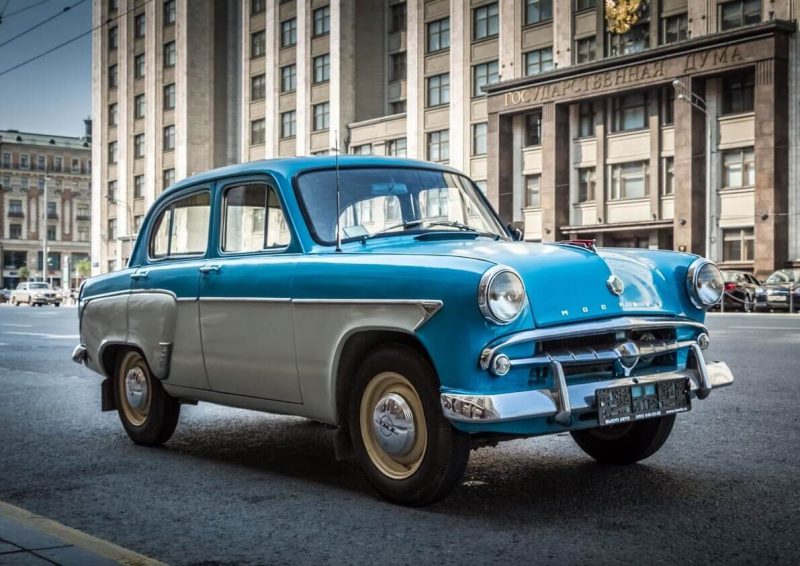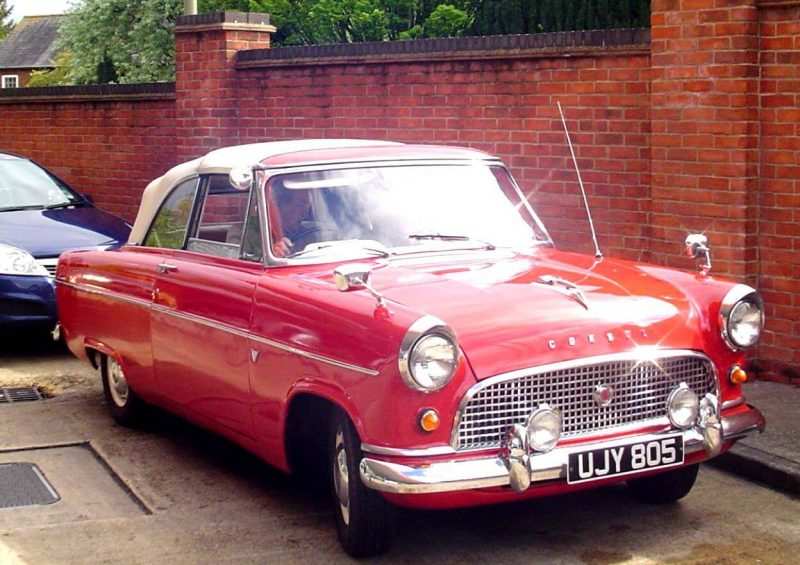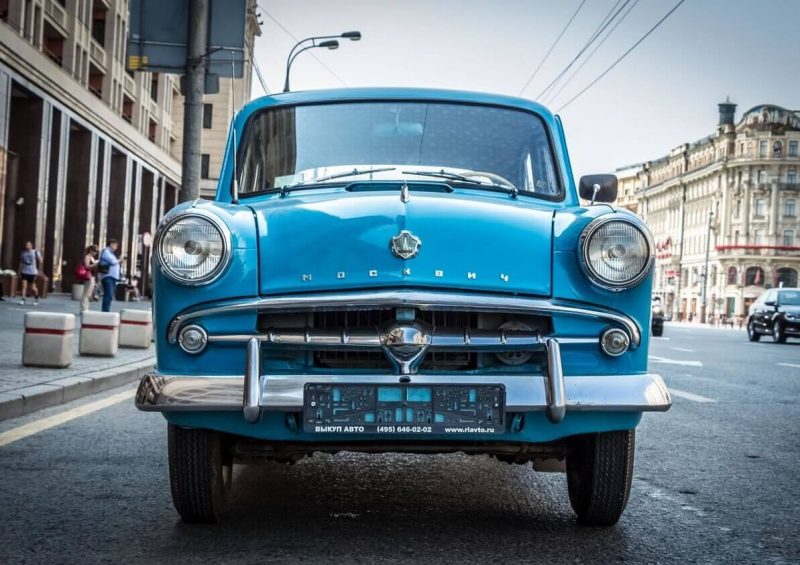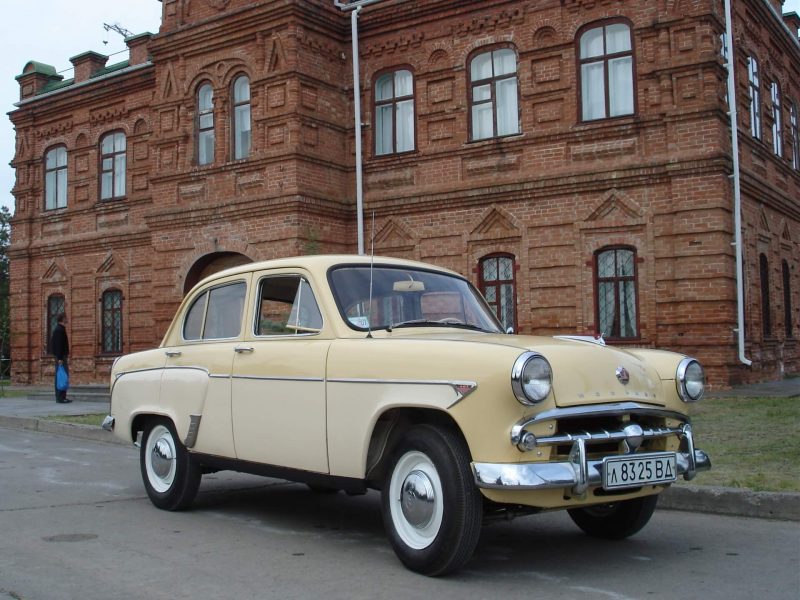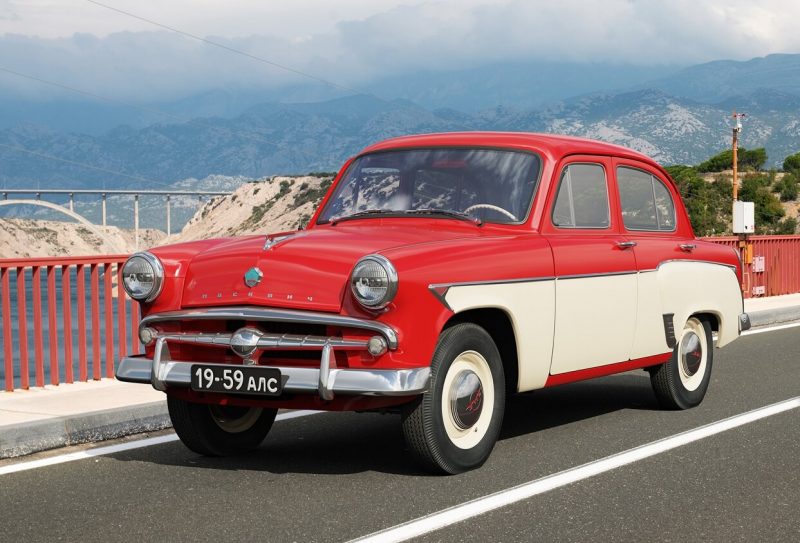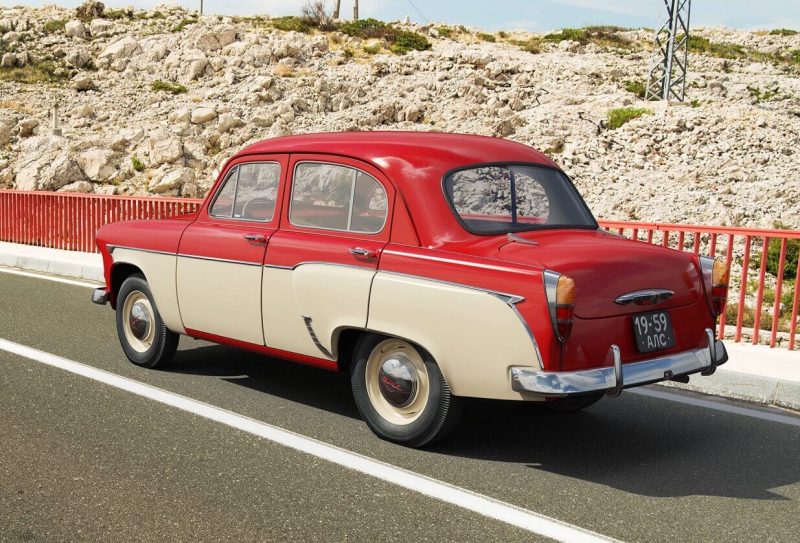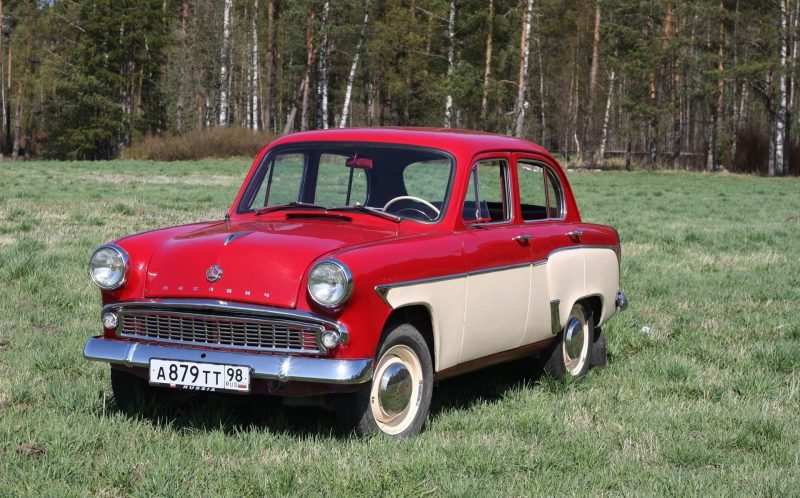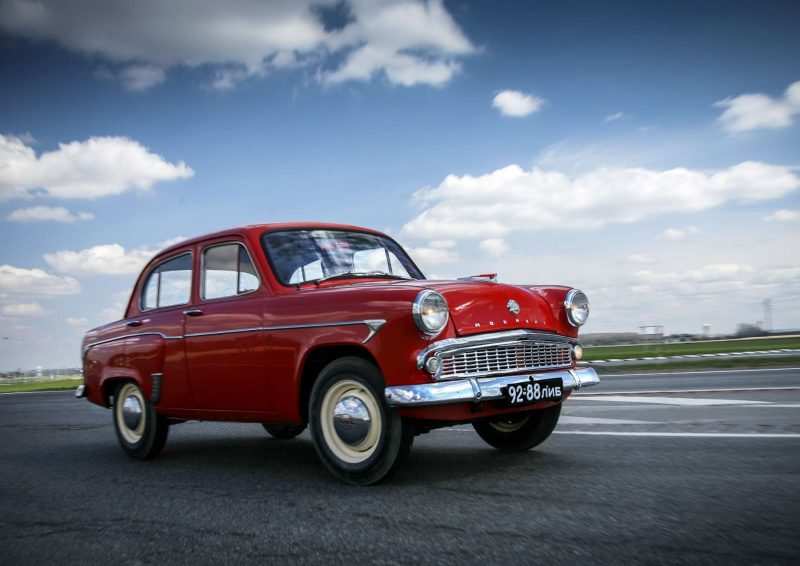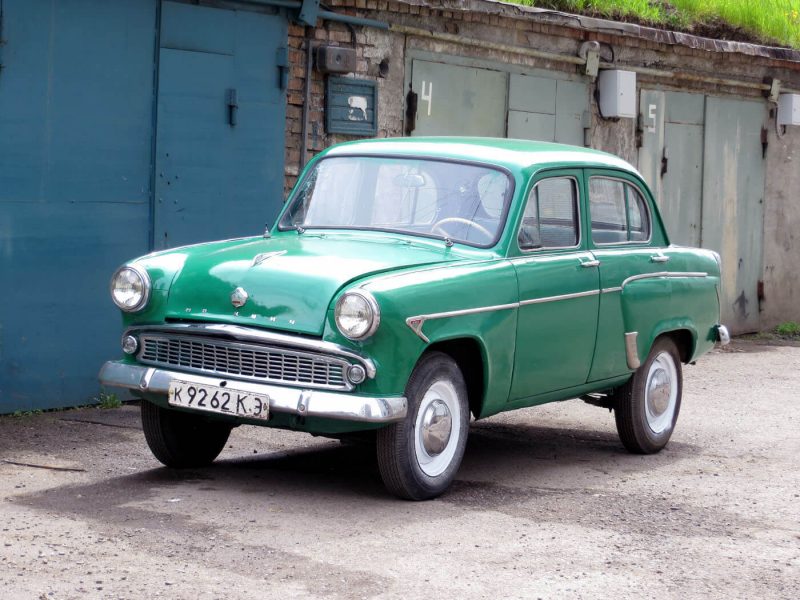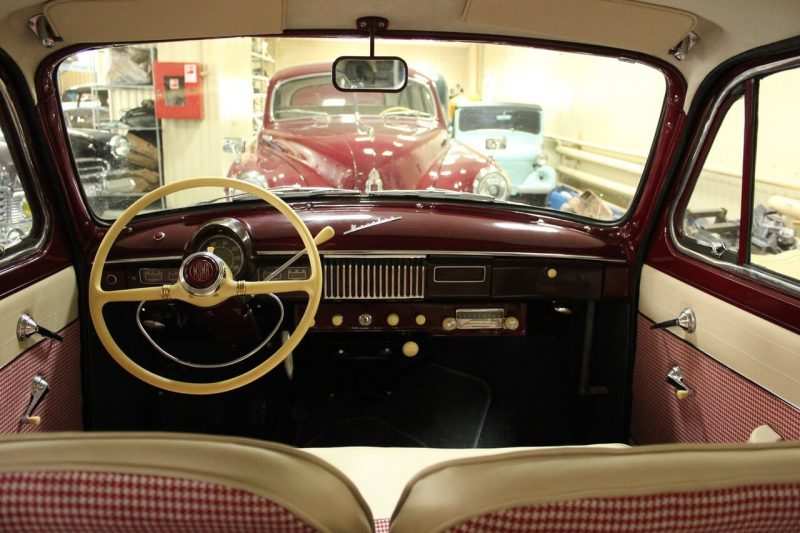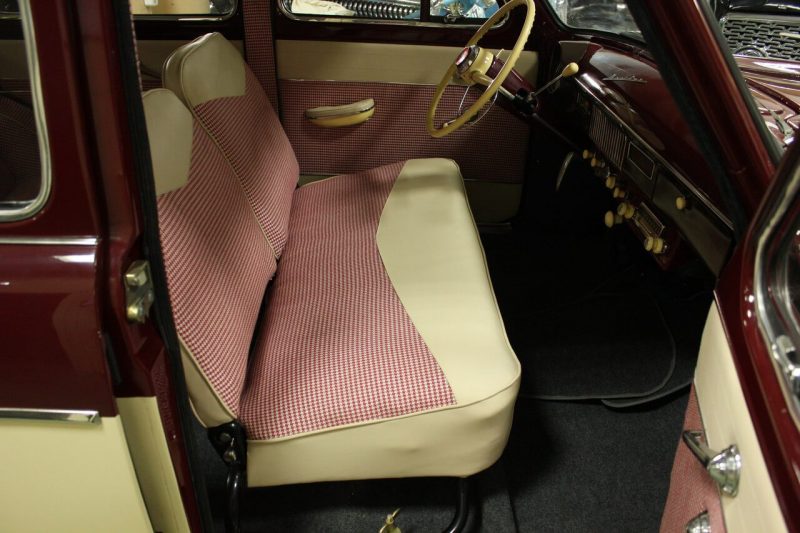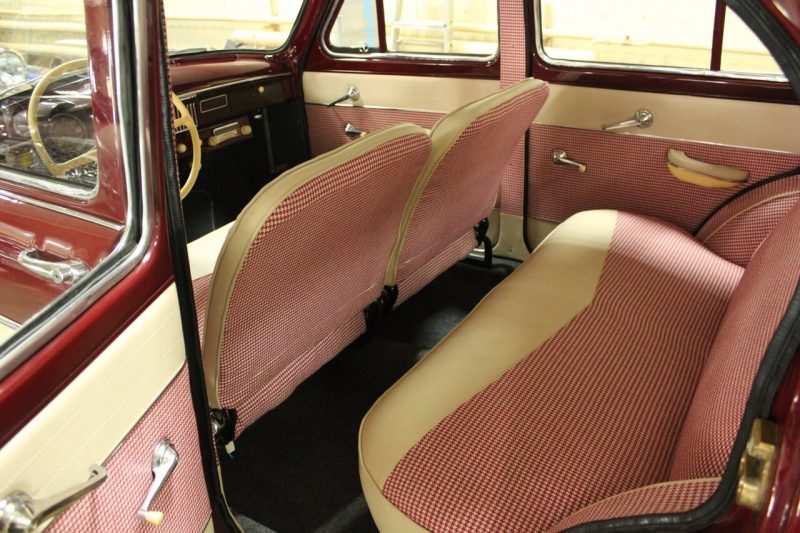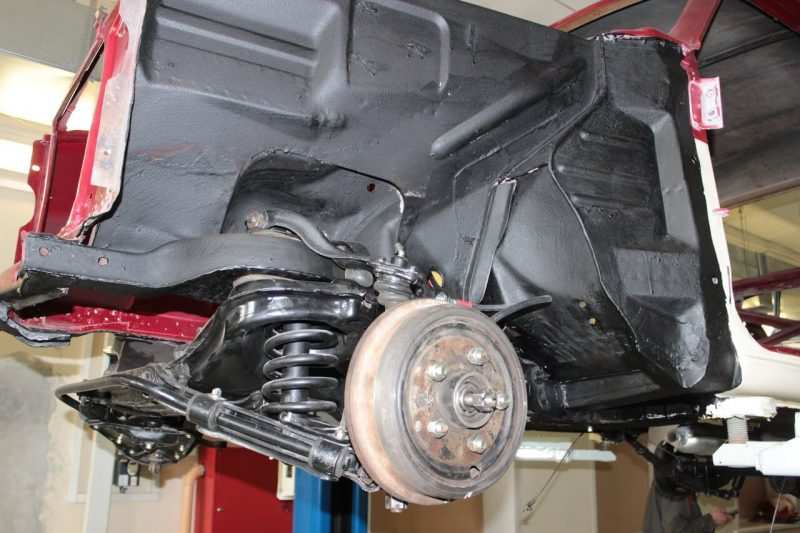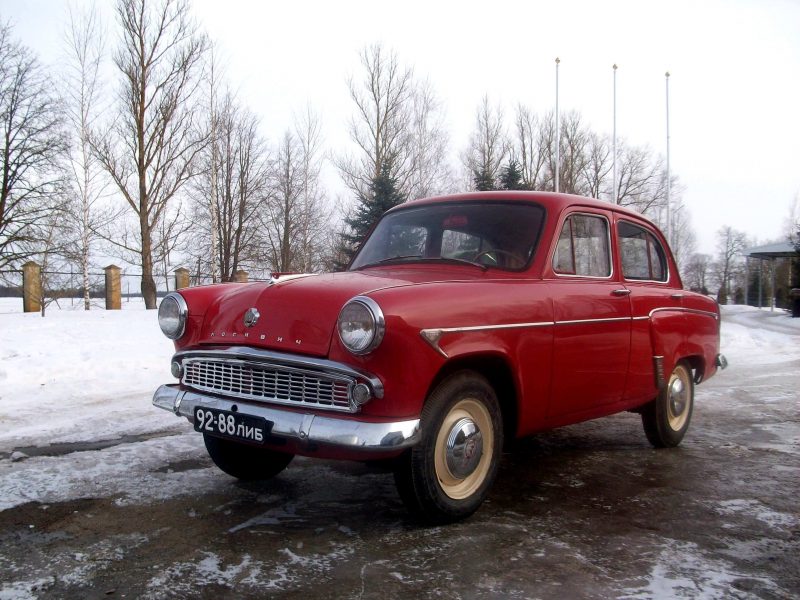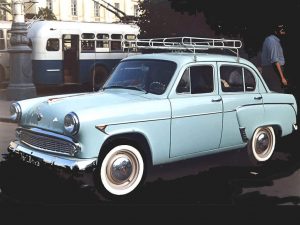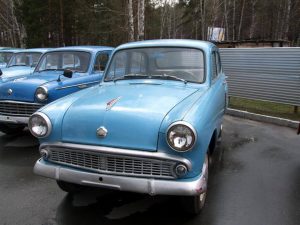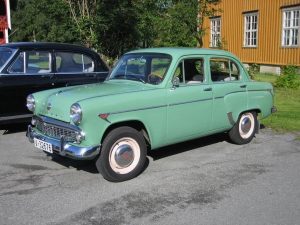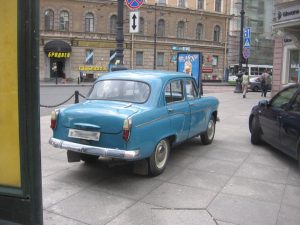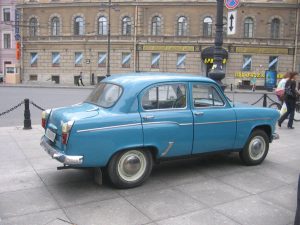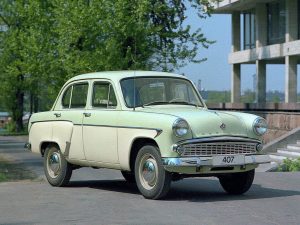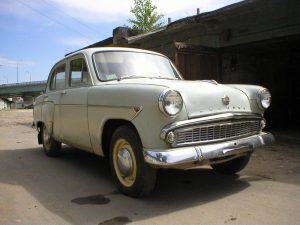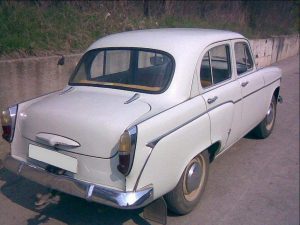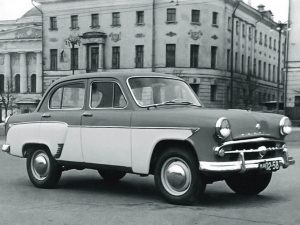Moskvich-407
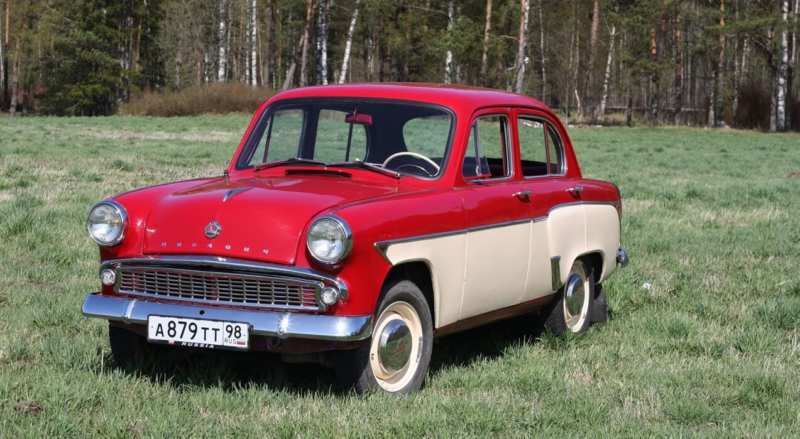
Moskvich-407 is a Soviet passenger car with a small size, upgraded version of the 402nd model with an improved overhead valve powertrain and improved finishing. The car was produced at the Moscow Automobile Plant in the period from May 1958 to December 1963. In total, the company produced 359980 cars. The whole model range is Moskvich.
History
At the onset of 1951, at that time, the real copy of the Opel Cadetta – 400th Moskvich began to become obsolete and lose to many machines of the time. Therefore, decided to issue an order to improve the model and its reissue.
Andronov was the chief designer, however, he (and the entire staff of the Moscow Small Vehicle Plant) did not have as much experience in designing modern cars as they could be competitive, so they decided to involve the design staff of GAZ, represented by Belkin, Kirsanov and Nemtsov, in the work.
In addition, the specialists of ZSa, represented by Chuzarov, Zheryadin and Gladilin, began to help as well. Okunev, who worked at the Moscow Motorcycle Plant, also came to the aid of Okunev to work with technical areas of sedan.
The debut model of the new car was similar in many respects to the English Ford Consul. It is clear that such result could not satisfy neither the state commission nor the design group itself. As a result, the work on the car dragged on for another 4 years.
At the beginning of 1955, 12 cars were again demonstrated to the commission. One of the models, however, was approved. Therefore, from the spring of ’56, it was announced that the production of the 401 model would be stopped and the production of the 402 model would begin.
Despite the fact that the new car had a number of innovations, including the presence of panoramic glass, steering wheel with a pair of spokes, door handles and telescopic shock absorbers, it still had a “share of archaism”.
This opinion also applied to the power unit, gearbox, which showed almost similar readings, if you take the previous car, Moskvich 401-th. Realizing the reality of the situation, the design staff began to refine the missed moments.
Two years later (May 1958) the debut sample of the restyled model, which received the index M-407, came out of the assembly line. After the upgrade, the engine already had even more power, which allowed the car to reach a maximum speed of 115 km / h (10 kilometers per hour more than its predecessor).
In addition, we decided to add the presence of modern moldings and a starter, and the car already needed gasoline A-72. It is logical to conclude that the cost of the car began to rise due to the improvement of efficiency and power. If the price policy of the 402nd model was about 15,000 rubles, the new car with the index M-407 was estimated at 25,000 rubles.
From the words of the chief designer Andronov it turned out to be a very unusual story. According to him, in the autumn of 1959 was the next meeting of the President of the United States of America, Eisenhower, and Khrushchev, which (which is not surprising) came to talk about cars, or to be more precise – about Moskvich-407.
The U.S. president said that it would be nice to experiment, putting on trial several models of Moskvich in their country. He also said that he could buy this car for his own ranch. The enterprise in Moscow immediately received an order to produce three copies of the machine, which began to be produced directly in the experimental fur shop.
All three cars had a full guarantee, improved finish, expensive interior upholstery, a lot of additional parts and products in the finish. The cars to be exported were painted raspberry, yellow and green. After that, the vehicles decided to disassemble, assemble, adjust and double-check all the units.
After 10-12 days, after round-the-clock work, the “high-test” machines were handed over. However, they were not to be allowed to travel long distances. A scout Powers of American origin flew over the Soviet Union region and was shot down very soon. Interestingly, however, even before the Soviet military noticed the American spy, Eisenhower was told that he would never allow the Moscow plant’s cars to enter the American market.
However, despite this, the car continued to enjoy great popularity in the Soviet Union itself, as well as in some other countries. One in three vehicles went abroad, and during the entire period of their production the number was 120,903.
It is clear that the machine had its own shortcomings, however, it took years and some problems were eradicated, and the machine continued to improve continuously. A year later, following the launch of the conveyor belt, the three-speed gearbox was replaced by a four-speed gearbox, and a couple of years later the rear axle was replaced by a hypoid one.
Exterior
The changes also concerned the appearance of the Soviet sedan. For example, when the 1960s came, they decided to change the radiator grille, and the rear lights already had 3 diffusers. Next year, a metal “drop” was chosen as the nameplate. Already since 1962, his usual “fangs” have disappeared on the bumper.
Also then it was decided to increase the warranty on the mileage of the vehicle to a mark of 15 thousand kilometers. A year later this mark was increased to 20 thousand kilometers. Export variation of the vehicle was, as a rule, right-hand drive and had two-color body painting, improved exterior and more expensive interior.
In general, the Soviet vehicle had a carrying body with four doors and an external luggage compartment. But the 400th vehicle had a trunk, but it could only be approached from the inside. The appearance of Moskvich-407 fully corresponds to the era of the 1960s.
There are no sharp corners, the main headlights are moved forward, the body was made of solid layers of metal, and the hood turned out to be rounded. The car can also be found on the presence of chrome moldings.
If we take into account the fact that specialists of the Gorky Automobile Plant also worked on the design component of the car (which produced popular cars and trucks), the car could be called a “reduced copy of the 21st Volga” from time to time. But if you think about it, in fact, these sedans have a lot in common, but they are all unique in their own way.
Moskvich had a curved windshield, which was slightly convex, which, in turn, increased visibility. The hood was made of a metal one-piece piece, and the auxiliary stiffness was added to it by amplifiers, which were installed diagonally and transversely.
The bonneted department received an alligator type, and the chrome ledge in the central part from the windshield to the outer edges of the machine allowed the machine to be more stylish and slightly aggressive. By the way, Moskvich’s nameplate was on the nose of the hood.
A fuel tank was provided for the fuel, the volume of which was already 35 liters. They decided to install it at the back, under the bracket of the license plate. Such an action is quite successful, as it was possible to become any party to the gas station.
The upper part of the windshield had a rear-view mirror, and the whole body was decorated with a chrome shaped molding.
Automobile bribed customers with its small size, increased functionality, as well as many advanced spare parts.
When 1961 came, the designers decided to modernize the radiator a little bit – the cross beam was replaced by a multi-slot grille. After a while they came to the hood – removed the red flag made of plastic, and instead put a “drop-shaped” part of the metal. The final stage of the body change was the removal of bumper canines. This happened at the end of the winter of 62nd year, after which the 407th did not change until its completion.
They decided to paint the body with synthetic car enamels, and even 2-color painting was used for luxury cars. Safety buffers installed at the front and back made pressed, chrome-plated, composite construction and without fangs. In order to make it convenient to repair the body, its front and rear wings were made removable.
Interior
The standard equipment of the vehicle of the Moscow plant of small-capacity cars had a dual-band six-lamp radio receiver A-17. The windshield, mentioned above, was protected from sweating by warm air from the built-in heater. The seats inside the sedan could be laid out in a flat sleeping place, and the driver’s seat could be quickly adjusted in the longitudinal direction with the help of a fixing lever.
This innovation was very nicely received, because even by European standards, such opportunities were not cheap. The dashboard had a speedometer (programmed to 140 km/h), an odometer, an ammeter, fuel level, oil pressure and water temperature indicators.
Speaking of control lamps, there were only two of them at first. The small blue one, which was responsible for the main beam on the speedometer, and the white one, which said that the heating system fan was on, which in turn had a translucent control knob with three speeds.
It was possible to monitor the activation of the direction indicators by the state of the small lever, which was white and was located on the steering column. It was only by 1961 that a light bulb was installed on the dashboard, with a red diffuser that made it possible to control the operation of the direction indicators.
The hood could be opened with the handle under the “glove box” near the front passenger door. The luggage compartment, on the other hand, would open the handle that had found its place under the rear seat on the right side.
It turns out that in order to get into the luggage compartment of the vehicle Moskvich-407, it was necessary to first open the back right door. Speaking of the handbrake lever, I would like to say that it was placed under the panel installed in front, to the right of the steering wheel.
When necessary, it was possible to turn off the handbrake with one quick blow of the hand. But in Zhiguli it was necessary to press the button with a finger first, and then release the lever. The windscreen wipers were also mounted and mechanically driven by the power pack.
The interior of a small Soviet sedan was decorated with upholstery fabric and leather substitute. For example, the lower door part, together with the central body supports, the wall under the rear seat and the shelf behind it, part of the pillows and backrests of the chairs, were upholstered with leather. Inside the car, on the floor, as well as in the trunk there are rubber mats. The rear body side racks have hooks for clothes.
Specifications
Powertrain
Moskvich-407 had a new top-valve four-cylinder gasoline four-stroke carburetor engine with a volume of 1.360 liters, which produced 45 horsepower. The last engine of the Moskvich 407 was lower-valve and developed only 35 horses.
At the time, it was considered a real technical breakthrough. Before the advent of such a power unit, a lot of work had been done. Before the engines with overhead valves were put into mass production, such units were installed only on factory sports cars, which took part in the championships of the country and could show excellent results at such races.
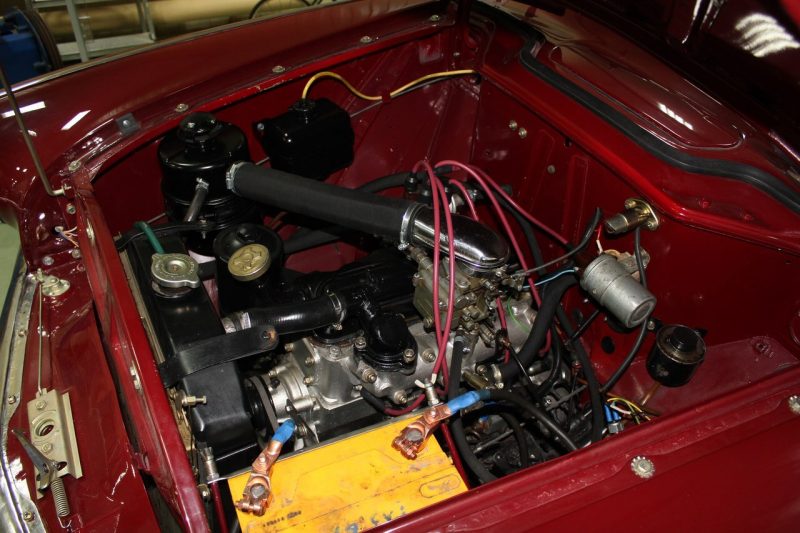
The motor development was carried out by Y.V. Goryachev, I.A. Gladilin, I.I. Okunev. The idea itself was quite simple. The design staff wanted to reach a compromise solution between the existing equipment (because there were no plans to replace all the machines that were at the Moscow plant) and the developing new design.
The alternative was to find an alternative: the cylinder block of the 407th model power unit was started to produce on the machines that already existed at the enterprise. A significant innovation in the engine was the presence of an aluminum cylinder head, as well as the upper position of the camshaft.
The first hundred vehicles in which 45-horsepower engines were installed were produced in 1957, and since May 58, the entire serial line of machines began to be equipped with such engines. The design staff was able to equip the car with a starter, which worked with the key.
Transmission
The first stages of the production of Moskvich 407-th allowed him to have a three-speed manual gearbox, which, together with the hypoid type axle, gave him the opportunity to accelerate up to 30 km / h, without leaving direct transmission. Since 1969, they began to install a 4-speed gearbox.
The clutch was dry and had one disc and a torsion damper. After December 1960, instead of a noisy main gearbox with spur bevel gears, a quieter and more reliable hypoid gear was installed.
Suspension
The front suspension was an independent spring with transverse levers, hingeless. It was assembled on a stamped crossbar. The rear suspension was located on a pair of longitudinal semi-elliptic leaf springs.
The suspensions included double-acting hydraulic telescopic shock absorbers at the front and double-acting telescopic shock absorbers at the rear. In terms of the chassis itself, it provided excellent engine elasticity and good sedan performance.
Road control
It was globoidal and had a two-crested roller. It is clear that no one talked about any hydraulic power steering in those years.
Brake system
It represented block (drum) mechanisms and had a hydraulic drive on all wheels. There was also a parking brake, which was at the rear and had a block type.
| Kuzov | 4-door sedan |
| Number of places | 5 |
| Power type | carburetor |
| Motor | four-stroke inline overhead valve |
| Size | 1358 cc |
| Power | 4500 rpm. (45 hp) |
| Max. speed | 115 km/hour |
| Acceleration time (up to 80 km/h) | 23-24 sec |
| Average fuel consumption | 6.5 l/100 km |
| Number of cylinders | 4 |
| Cylinder diameter | 76 mm |
| Piston stroke | 75 mm |
| Valve number | 8 |
| Torque | 2600 rpm |
| Coupling | dry, with one disk and torsion damper |
| Brake system | all-wheel-drive block |
| Stop brake | rear block |
| Gearbox | mechanical 3-step two-way (since 1969 – 4-step) |
| Pendant front/back | independent spring/independent longitudinal |
| Forward/rear shock absorbers | double-acting hydraulic telescopic / double-acting telescopic |
| Rotate diameter | 6-6.3 m |
| Brake track (at 30 km/h) | 6 m |
| Traffic clearance | 20 cm |
| Dimensions of d/n | 4055/1540/1560 mm |
| Wheelbase | 2370 mm |
| Weight | 990 kg |
Modifications
Along with the standard models of the Moskvich-407 car there were also other small-capacity passenger car modifications, which were produced from the 58th to the 63rd year.
| Moskvich-407T | there was a car with green lights and taxi “checkers”, which additionally received the equipment taximeter. |
| Moskvich-407B | represents a manually operated sedan. It was created especially for drivers with amputation or paralysis of legs. The car was distinguished by the use of a special system of manual control of clutch, brake and gas pedals, starter switch, as well as switching lighting. |
| Moskvich-407M | was a medical car that the nurses used to drive to patients. The model was designed to work as a “home health care”. The car had distinctive signs, a first-aid kit, and an interior car upholstery made of easily washed leatherette. |
| Moskvich-407U | represented a modification of the sedan for hot countries with tropical climate. |
| Moskvich-410H | the machine was manufactured between 1958 and 1960. It was decided to produce the model on Khrushchev’s own initiative. All-wheel drive passenger car had to be used in rural areas, which would allow to demonstrate well the improvement of welfare of collective farmers. However, the development of such a complex all-wheel drive vehicle was completed in favor of increasing the production of export variations of the standard vehicle. |
| Moskvich-423H | produced between 1958 and 1963. Cars in the body of the “universal” fit perfectly into the dacha owners, those who like to travel, but in the piece-by-piece implementation they went in small quantities. They were used most of all in state institutions. Such a modification was for a long period of time an unattainable dream of ordinary motorists. |
| Moskvich-411H | was released from 1958 to 1960. Represents the all-wheel drive version in the body of the “universal”. The model was ahead of its time, as the all-wheel drive and universal body was relevant only after 20 years. And at the time of manufacture, thanks to the expensive construction component, the car could not get a large spread. |
| Moskvich-430 | produced from 1958 to 1963. It is a special cargo version of the famous model. The car was not sold in private hands, however, it was well used in the trade state network to transport small batches of goods. Its platform was also used to produce a special refrigerator model LMZ-945 to transport ice cream and meat products. |
| Moskvich-407-coupe | is a special sports model for circuit and hippodrome racing. It had a double bodywork, which allowed it to be much easier. It was also planted lower than the serial version. A total of two such machines were made in 1962. |
Pluses and minuses
Pluses cars
- Fresher appearance compared to predecessors;
- Maximum speed – 115 km/h;
- Was a “people’s car”
- There are wipers;
- The heater is installed;
- There’s a lamp radio;
- There are various modifications;
- There is a hydraulic brake booster;
- Little price of the machine;
- Bigger powertrain than previous models;
- Sedan’s small size;
- Little weight;
- Sold even abroad;
- Adjustable driver’s seat (longitudinal);
- Qualitative body metal;
- Hypoidal transmission.
Cons of a car
- The appearance was still losing to foreign analogues;
- Hydraulic power steering was missing;
- Hydraulic power steering
- No seat-belts;
- Not adjustable steering column;
- Rear visibility mirrors are missing;
- Little free space inside;
- Incomfortable seats.
We sum up
Moskvich-407 turned out to be quite a widespread and successful vehicle, and not only in the Soviet Union. Its role, in part, was played by the participation of cars in various international competitions and races. Since the cars occupied prestigious places, they won respect, which, in turn, increased their demand, so the export of cars rose sharply. In general, Moskvich 407th did a lot for the development of motorsport in the Union of Soviet Socialist Republics.
On the platform of such a successful car created many modifications, which were used in various fields. Inside the model already had a heater, radio and adjustable driver’s seat, which was difficult to find even in European cars. It was quite easy to operate, despite the lack of hydraulic power steering, because the size of the car was modest, so it felt great in urban areas.
Often there was a lack of external rear-view mirrors and a more spacious interior. On the other hand, the front sofa could be folded together, and access to the luggage compartment was from the outside, not from the inside, as in previous models.
And in general, the car was much cheaper than the famous Volga. The engine was not the most powerful, but allowed to be quite a sharp Soviet sedan. It is necessary to tell about a qualitative body metal thanks to which some copies are still on the move. Indeed, Moskvich 407-th forever went down in the history of the Soviet automotive industry.
We advise you to read the article: History of the car “Moskvich” and AZLK enterprises


